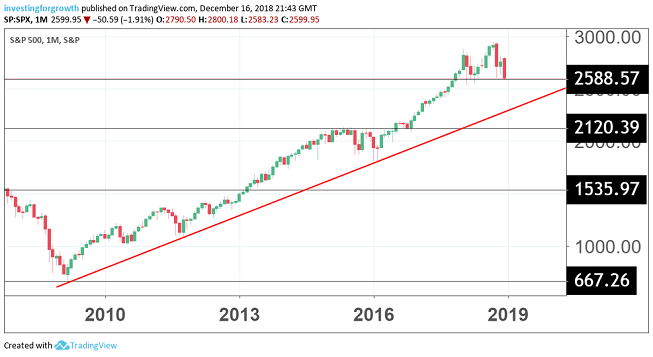US stocks in 2019: Can record profits really extend equities bull run?
20th December 2018 08:57
by Graeme Evans from interactive investor
Bond yields suggest America could enter recession in 2019, but there are still opportunities for 'vigilant, well-positioned investors', explains Graeme Evans.

With Wall Street's longest ever bull run nearly 10 years old, there's no shortage of market speculation predicting that 2019 will mark the end of the cycle.
That's certainly the view of bond markets, with the difference between yields on five-year and shorter-dated US government debt suggesting an American recession is possible within the next year to 18 months.
With the S&P 500 close to where it started 2018 after heavy falls since the start of October, it's likely that market volatility is here to stay. However, Bank of America Merrill Lynch research analysts also think there's still room for "one last hurrah" from Wall Street and other stockmarkets.
They note that US fundamentals remain sound, particularly with a record high peak in earnings projected for S&P 500 companies next year, as well as potential upside for investors who can stomach the volatility.
Candace Browning, head of BofA Merrill Lynch Global Research, said: "In our view, the current weakness in the markets is not a reflection of poor fundamentals.
"Rather, it's caused by a confluence of idiosyncratic shocks that create very real risks for investors to be concerned about but also opportunities for vigilant, well-positioned investors to pursue."
The biggest wild card risks facing investors in the US will be the outcome of the trade dispute with China, as well as the potential for political gridlock in the US that could slow capital investment and knock investor sentiment.
Donald Trump's fiscal stimulus plan from early 2018 is also starting to fade, meaning that US earnings per share (EPS) growth will slow from 15% this year to 5% in 2019. But as BofA Merrill Lynch points out, that still puts the S&P 500 EPS at a record high of US$170 next year.
While US stocks are far from cheap, the bank thinks the S&P 500 still has the potential to top 3,000 before settling at 2,900 by the end of the year. Its equity strategists are overweight in healthcare, technology, utilities, financials and industrials.
They are underweight in consumer discretionary and real estate, reflecting the fact that the housing market is no longer a tailwind for the US economy, with housing sales likely to have peaked and prices forecast to slow.
This comes amid predictions for at least three more interest rate increases from the US Federal Reserve, taking its policy rate to 3% or more by next summer.
S&P 500

Source: TradingView (*) Past performance is not a guide to future performance
The distance at which the US economy has diverged from the rest of the world is highlighted by the fact that analysts do not expect policymakers in Europe and Japan to raise rates above zero for at least another two years.
With US rates approaching their peak, analysts at Schroders are expecting an end to the recent US dollar strength. They said: "Although the difference between US interest rates and those elsewhere will remain in favour of the US, currency markets are likely to have priced this in already.
"We think currency markets will increasingly focus on the growing budget and current account deficits in the US, which will drag the currency lower."
Schroders sees US GDP growth at 2.4% in 2019, adding that it expects the Fed to "look through" above-target inflation in order to take into account the effects of slower growth. They forecast rate cuts in 2020 as the US economy cools.
In the meantime, there are still opportunities to be found on Wall Street, particularly as share buy-backs tend to play a much greater role in the US than in Europe.
Stefan Schneider, chief German economist at Deutsche Bank Research, said total buyback volumes could climb to a new record of around $1 trillion. For 2019, he also expects solid earnings growth of up to 10%.
Schneider added:
"US stocks will remain attractive, although they are not cheap by international standards."
*Horizontal lines on charts represent levels of previous technical support and resistance. Trendlines are marked in red.
These articles are provided for information purposes only. Occasionally, an opinion about whether to buy or sell a specific investment may be provided by third parties. The content is not intended to be a personal recommendation to buy or sell any financial instrument or product, or to adopt any investment strategy as it is not provided based on an assessment of your investing knowledge and experience, your financial situation or your investment objectives. The value of your investments, and the income derived from them, may go down as well as up. You may not get back all the money that you invest. The investments referred to in this article may not be suitable for all investors, and if in doubt, an investor should seek advice from a qualified investment adviser.
Full performance can be found on the company or index summary page on the interactive investor website. Simply click on the company's or index name highlighted in the article.